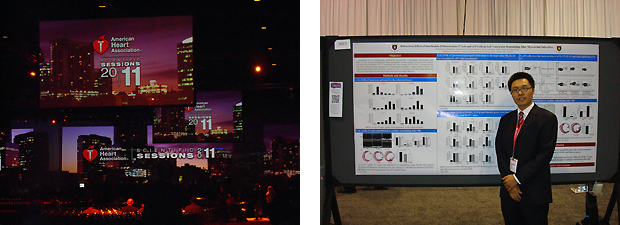Young Researchers' Trip report
- 2012年度
- 2011年度
- 41st Annual European Society for Dermatological Research (ESDR) Meeting
(2011年9月7日~2011年9月10日) - XIX World Congress on Parkinson's Disease and Related Disorders
(2011年12月11日~2011年12月15日) - コモン・マーモセット生態観察記:ブラジル国北リオグランデ州ナタル市及びその郊外、北リオグランデ連邦大学及びその研究ステーション
(2011年12月11日~2011年12月19日) - 53rd ASH (American Society of Hematology) Annual Meeting
(2011年12月9日~2011年12月14日) - 浜松ホトニクスPETセンター
(2011年11月7日~2011年12月2日) - 41st Annual ESDR Meeting 2011 ウィーン医科大学皮膚科
(2011年8月29日~2011年9月11日) - 41st Society for Neuroscience (Washington DC, the United States of America)及び海外視察
(2011年11月12日~2011年11月27日) - 2011 ASCB (The American Society For Cell Biology) 51st Annual Meeting
(2011年12月3日~2011年12月7日) - American Heart Association-Scientific Sessions (2011)
(2011年11月12日~2011年11月16日) - Charite Universitats Medizin, Berlin(ドイツ、ベルリン)脳神経外科 留学記
(2011年8月~) - AACR-NCI-EORTC International Conference Molecular Targets and Cancer Therapeutics
(2011年11月12日~2011年11月15日) - 2011 Joint Annual Meeting, SIICA DGfI
(2011年9月28日~2011年10月1日) - Key Forum in developmental biology and regenerative medicine 参加報告
(2011年9月8日~2011年9月9日) - Key Forum in developmental biology and regenerative medicine 参加報告
(2011年9月8日~2011年9月9日) - Key Forum in developmental biology and regenerative medicine 参加報告
(2011年9月8日~2011年9月9日) - Key Forum in developmental biology and regenerative medicine 参加報告
(2011年9月8日~2011年9月9日) - Key Forum in developmental biology and regenerative medicine 参加報告
(2011年9月8日~2011年9月9日) - Key Forum in developmental biology and regenerative medicine 参加報告
(2011年9月8日~2011年9月9日) - Key Forum in developmental biology and regenerative medicine 参加報告
(2011年9月8日~2011年9月9日) - テキサス州立大学MD Anderson Cancer Center留学記
(2010年1月~) - 8th IBRO2011 WORLD CONGRESS OF NEUROSCIENE (Florence, Italy)
(2011年7月14日~ 2011年7月18日) - 8th IBRO2011 WORLD CONGRESS OF NEUROSCIENE (Florence, Italy)
(2011年7月13日~ 2011年7月20日) - 第15回International Congress of Mucosal Immunology
(2011年7月5日~2011年7月9日) - Singapore Gastric Cancer Consortium(4th Annual Meeting)
(2011年7月4日~2011年7月5日) - 第9回ISSCR (International Society for Stem Cell Research)
(2011年6月15日~2011年6月18日) - ASCO annual meeting 2011
(2011年6月3日~2011年6月7日) - APDRC,1st(Taipei, Taiwan)
(2011年5月22日~2011年5月25日)
- 41st Annual European Society for Dermatological Research (ESDR) Meeting
- 2010年度
ホーム > Young Researchers' Trip report > American Heart Association-Scientific Sessions (2011)
American Heart Association-Scientific Sessions (2011)
氏名
Yan Xiaoxiang
GCOE RA
内科(循環器)
詳細
GCOE Young Researcher Support Plan(2011年度)
参加日:2011年11月12日~2011年11月16日
活動レポート
I have a chance to attend the America Heart Association (AHA)-Scientific Sessions (2011) hold in Orlando, USA during Nov. 12-16, which is the biggest conference on cardiology with more than 30,000 participants in the world. In our department, more than 10 doctors attended this meeting, most of them had the oral or poster presentation. I was really excited because this is the first time I visit USA, visit the beautiful city, Orlando, it is such a beautiful and comfortable city. All of us enjoyed the traveling.
The conference had seven core sections, containing myocardium function, vascular disease, cardiac imajing, etc, which almost includes all the frontier information about clinical and basic science of cardiovascular medicine. And it was a great learning experience for me. Many many famous speakers around the world including from Japan have brought their very recent work to the audiences. In the Melvin L. Marcus Young Investigator Award in Cardiovascular Sciences Finalist, Dr Qian reported their recent finding, they induced the fibroblast into functional cardiomyocyte, these cardiomyocyes almost had the characteristics of adult cardiomyocyte, when transplated into the infarct heart, the cardiac function was significantly improved by these induced cardiomyocytes. The second speaker from Iowa Univ. found that aldosterone enhances cardiac rupture after myocardial infarction via oxidation of calcium/calmodulin-dependent protein kinase II, which is very promising research in the therapeutics. Dr. Enomoto from our lab also report their excellent work, in which they found that the impaired interaction between titin and MURF1 is a novel mechanism for the pathogenesis of hypertrophic cardiomyopathy.
On the second day of the conference, I was able to share my research work on IL-23/IL-17 axis in the cardiac remodeling with people from different countries. In this conference, there was not so many topics on immunology and cardiovascular disease, so many people are interesting with my work, especially my beautiful flow cytometry data in a specific organ-heart.
I got a lot of cutting edge knowledge from this conference. I really appreciated this opportunity to participate this meeting. I am also grateful for GCOE for their generous support, with all the travel expense.

Copyright © Keio University. All rights reserved.
